The AristoCats: Special Edition
by Ben | August 26, 2012 12:20 pm
Walt Disney Productions (December 24 1970), Walt Disney Home Entertainment (August 21 2012), Blu-ray and DVD, 79 mins plus supplements, 1080p high-definition 1.66:1 widescreen, DTS-HD Master Audio 5.1, Rated G, Retail: $39.99
Storyboard:
Slinky feline Duchess (Eva Gabor) and her three pampered kittens, Berlioz, Marie and Toulouse, have it made when their eccentric Paris millionairess owner Madame Bonfamille plans to leave them her entire inheritance. This doesn’t go down too well with the snooping, untrustworthy butler Edgar, who feels his years of service should be rewarded rather than have to continue caring for the cats. Proving the old adage that “the butler did it”, Edgar hatches a plot to dispose of Duchess and her family, a plan that soon goes awry, leaving the kitties lost in the French countryside. Thinking that he’s gotten away with it clean, Edgar hasn’t counted on Duchess meeting up with alley cat Thomas O’Malley (Phil Harris) and an assortment of crazed geese and artistic bohemian hepcats who all offer to help Duchess and her kittens make the long trip home…

The Sweatbox Review:
At one time (and for a long while) the Disney film that got a bad rap and undue dismissal even from Disney fans themselves, The AristoCats has, largely thanks to success on home video and the children – now adults – that saw it originally in theaters, in recent years finally become something of a rediscovered classic. This is quite right and, as appreciative fans will tell you, long overdue, since the movie was actually always an important one in the Studio’s history, not to mention being very fun and highly entertaining! It’s often remarked that Mary Poppins and The Jungle Book were among the last films to carry Walt Disney’s thumbprints on them, but the truth is that Poppins was released two long years before his death, and of course he already had several films in production before he departed for that mother of all theme parks in the sky. Blackbeard’s Ghost, The Happiest Millionaire, Boy-Car-Girl, which eventually became The Love Bug…all these films had been in various states of production before he fell ill, and he had approved scripts, casting and even some finished music and songs.

It’s true that Walt passed away during the production of The Jungle Book, and that the huge success of that film could at least be partly attributed to audiences wanting to enjoy the Mousetro’s final animated picture, but Disney had actually already given the thumbs up to the animation department’s next feature. Devised by Ken Anderson in the mid-1960s, The AristoCats was very much a film that Walt Disney knew about and was involved in. In fact, it was Walt who decided the tale be told as an animated feature after it was initially suggested as a two-part live-action film for his weekly TV show. The big question, after he had died, was how to continue. The top brass, including Walt’s brother Roy O. Disney who was now effectively running the company, didn’t have a handle on how the animation unit worked. Walt had passed the reigns to director Woolie Reitherman, who had helmed various projects for the Studio throughout the 1960s and became the ringleader in pulling the team through The Jungle Book. With that film’s triumph very much to do with the way Reitherman kept production going throughout the turmoil of the loss of the company’s founder, he was a natural to continue in the role of overseeing the unit’s next outing.
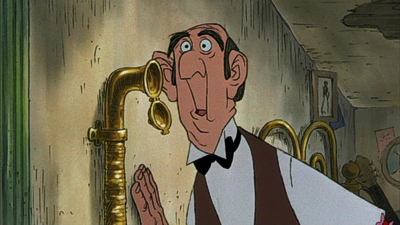
In truth, it has to be admitted that The AristoCats is a slight reworking of One Hundred And One Dalmatians, crossed not with Lady And The Tramp as is often stated, but by way of Chuck Jones’ earlier UPA feature Gay Purr-ee, in which Judy Garland’s pampered feline is lost and has to fend for herself in the big city, and against a wandering (orange) lothario cat. Anderson’s concept added three kittens and a villainous element to the mix, and while unscrupulous butler Edgar is no Cruella De Vil, he’s still got some pretty dastardly plans for the kitties. Over time, Edgar’s cat-napping scheme goes bad, the cats are lost in the big city and mother cat Duchess has to fend for her young as well as against the advances of a wandering (orange) lothario, Thomas O’Malley, an alley cat with a warm heart. O’Malley provides a lot of grounding to the film, as well as a pass to stay with his swingin’ Parisian pal Scat Cat and his band of jazz-playing feline friends. With her neighborhood just around the corner, Duchess and the kittens should be home free, but the ever resourceful Edgar has come so far and is determined to see them off in order to claim his employer Madame Bonfamille’s vast inheritance.

With this darker and more complex plot than it ever gets credit for, a lot was riding on the success – or failure – of The AristoCats. If it had been an out and out failure, it could have spelled the end of Disney Animation as we knew it then. Luckily, audiences at the time made the film a more than modest success, paving the way for the Studio’s artists to continue drawing away. Since its debut, however, the film picked up something of a bland reputation, and I’m still rather puzzled as to work out why (forgiving some of the easy to target anachronisms such as why Edgar sees American dollar signs when he hears about the inheritance, and how all the signage in France is in English!). I wonder if it was because, as with Pocahontas coming on the back of the huge hit of The Lion King, it needed to follow up the kind of gigantic success it could never achieve even with all the cards stacked in its favor? A popular mentality seems to be that it’s “missing the Walt touch”, but then he had approved the story, and there were many other projects he either wasn’t directly involved in or had less to do with that never got this level of derision. Perhaps it was because The AristoCats fell into that middle ground where it was still not yet old enough to be labelled a grand classic in the Pinocchio or Bambi mould, and not successful enough to equal the popularity of the biggest recent blockbusters…?
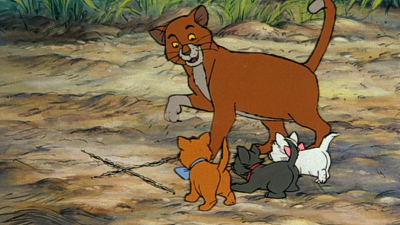
It’s true that the film isn’t the most original of outings: the plot for one thing is begged, borrowed and stolen from other animated movies (there’s even one shot, with O’Malley falling off the back of a truck, that’s an exact duplicate of the same scene in Dalmatians), and is at times fairly episodic. It’s true that the Studio relaxed a little with the voice cast, bringing back the proven Jungle Book breakout star Phil Harris as the male lead, where he basically reprises his Baloo the bear, as he would again do even more transparently two years later in the Studio’s next, Robin Hood. As always the characters couldn’t be more the same: O’Malley possesses the same streetwise attitude and easy going nature that sees him slip effortlessly through life – he even gets to sing about his own Bare Necessities in a song (again by Terry Gilkyson) that, given a little more bounce, could jingle like a Baloo carbon copy – but snaps out of the haze and jumps into sincere action when the need arises. The rest of the cast, too, essentially continue the Jungle Book trend of playing caricatured versions of their established personalities, the most notable of which is Eva Gabor, who would go on to play the same kind of role in The Rescuers, and there are others – including the ever dependable Sterling Holloway – who had or would go on to voice other similar characters.

But there are very good things too: the Xerox-style artwork suggests a contemporary air even within the period 1910 setting, expertly delivering authentic-era, Parisian toned backgrounds reminiscent of Toulouse-Lautrec and the bohemian artists of Montmartre while making the film timeless for audiences of the day and still now. The animation is among the best the Studio produced during this age, at times outshining the animal work in The Jungle Book and laying the groundwork for the films to follow. It certainly surpasses the rather lazy approach to Robin Hood the Studio would tackle next (now there’s a safe movie that gets a lot of kudos for some reason!), and remained a quotable movie for recycled animation shots well into the Eisner/Katzenberg era, also unquestionably influencing Don Bluth’s own independent short, the delightful Banjo The Woodpile Cat, that has so many similarities they’re too numerous to mention, not least the casting of Scatman Crothers, later of Bluth’s semi-take on the same themes Banjo The Woodpile Cat, Bakshi’s infamous Coonskin and Kubrick’s The Shining, here playing a role originally intended for jazz legend Louis Armstrong (and not Jungle Book’s Louis Prima, as is usually inferred), of whom Walt was a big fan.
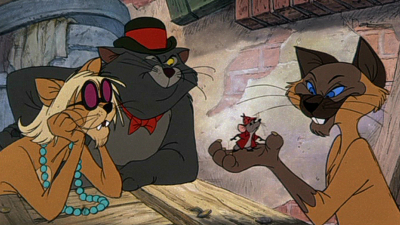
So The AristoCats became a hard film to pigeonhole in the Disney canon – on the one hand it’s a leftover from Walt’s time, on the other a transitional project that rested on the shoulders of many of the Nine Old Men and their need to prove their ability to continue without Walt. It’s also deserved of more than a little leeway for being an original project: for all of the derivative elements, The AristoCats was the first Disney feature not to be based on any source material since Lady And The Tramp some fifteen years before, making it, by my count, only the third Studio-generated concept after Dumbo, and the last until the mighty roar of The Lion King, itself an amalgamation of multiple influences. It’s these little aspects that seem to have finally filtered out into the fans and general audiences’ only recent acceptance of the film, and further places The AristoCats in a unique bracket of the Studio’s movies. If the story can be argued to stop in one place for a little too long, surely that’s the pay-off for being treated to an original screenplay?
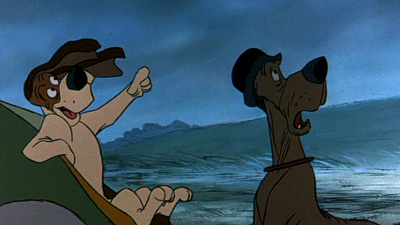
And the story, simply put, is fun! It’s got a no-nonsense approach – the set up comes early and economically, delivered in a clever way and mapping out what Edgar must do in order to swing the plot into action. The butler’s attempts to drug and cat-nap the kitties in the dead of night is expertly played in pantomime, allowing the artists the time for some wonderful behaviour animation that actually rounds Edgar out as one of the Studio’s fullest and realistic personalities. His eventual run-in with country hounds Napoleon and Lafayette creates an exciting sequence and introduces two of the truly funniest, non-grating comics in the Disney line-up. On the way home, Duchess and the kittens’ narrow escape from a steam train is played strictly for suspense, distinctively without musical score, helping it to remain a strong memory that’s routinely influenced other movies. O’Malley’s eventual rescue of Marie feels very involving, we even get some sly pokes at the French penchant for wine in the form of a very drunk goose, Uncle Waldo, and the sight of a mouse, Roquefort, seemingly chasing a bunch of alley cats.
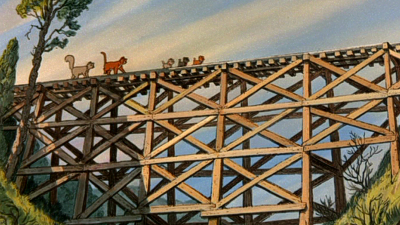
And, hey – we haven’t even yet touched on meeting Scat Cat and pals for the movie’s signature song, Ev’rybody Wants To Be A Cat! Unlike The Jungle Book, which is almost a perfect animated film but does dip badly after the double whammy exuberance of The Bare Necessities-I Wan’na Be Like You midway point, The AristoCats saves its swingin’ trick up its sleeve for later in the movie, and an enjoyable “final curtain” reprise. In fact, re-watching the movie again after so many times over the years, from the outset (where Maurice Chevalier famously came out of retirement in “respect for Walt Disney” to sing the Sherman Brothers’ jaunty opening scene setter) and through the many other highlights, it soon becomes clear that for all the negatives one could throw at The AristoCats, it is in fact very tight, without an ounce of fat on it, and with a momentum that strides along at a very even pace. It rests when it needs to, but usually fills in those moments with a subtle progression, to develop a character or set up a situation for a later payoff.
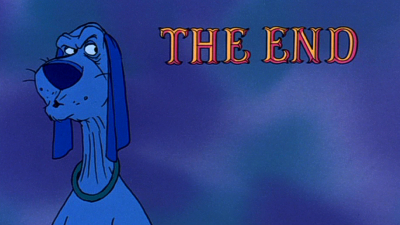
But because it’s almost so good, The AristoCats often found itself being compared to the much stronger titles from the Disney line-up, with which it can’t quite compete. Put it up against the similarly French-themed Ratatouille and it doesn’t stand a chance, but what other animated movie would? The episodic nature can’t entirely be excused, but then again what road movie can’t be called episodic? How about the derivatives? Point me in the direction of something that doesn’t have their elements cribbed from somewhere (even Ratatouille nods its head in this direction once or twice). Essentially, The AristoCats is a very good little movie that is very much more than the sum of its parts, and it has pleased me no end that in the last few years, those that grew up on it have stepped out in support and, in some cases, have named it as their favorite animated film. While I wouldn’t quite go that far myself, and even though it may not be totally purr-fect, you will find these jazzed-up, toe-tappin’ Cats have certainly got the cream!
Is This Thing Loaded?
After an initial 1.33:1 framed Gold Collection title release on DVD, a later special edition announcement for The AristoCats suggested that a two-disc set was in the works – but this was something to never materialize, the eventual disc simply providing a new 1.75:1 transfer (the film was created in the 1.37:1 open matte process, it was rumored a second disc might have simply contained an alternate ratio presentation and/or an extra helping of features destined one day for Blu-ray). Well, that day has come and unfortunately in terms of supplements there are no newly added revelations to what we have seen before, with Disney taking the usual BD route of actually dropping some of the more frivolous extras this time out. On loading the disc, Disney’s current roster of Sneak Peeks autoplay (or are selectable from their own menu option): here the likes of Cinderella’s Diamond Edition, Finding Nemo’s 3D return to theaters, Tinker Bell’s Secret Of The Wings, The Rescuers 2-Movie Collection, Beverly Hills Chihuahua 3 and Planes are previewed among other Disney promos.
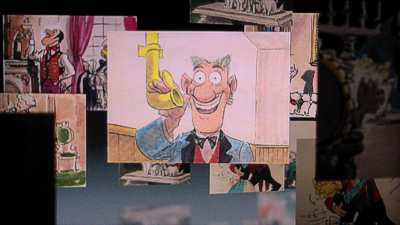
New for this Blu-ray is The Lost Open and, no, that’s not a typo (it’s also how it appears on the disc’s menu), but considering that this 9½ minute HD featurette reveals an entirely different beginning to the film, shouldn’t it be The Lost Opening? Anyway, our host is the film’s co-songwriter, the wonderful Richard Sherman, who pops up amid a selection of abandoned AristoCats concept art to describe an alternate opening sequence in which Edgar was to originally have a besotted female maid, Elvira, helping him to attend to Madame Bonfamille’s needs. Hearing that Madame’s inheritance’s was to go to both of them, the greedy Edgar begins to woo Elvira with a song, performed here by Sherman. It seems Elvira was probably cut from the film as she would have largely been a redundant character, perhaps filling the same kind of role as Frou Frou in being suspicious of Edgar’s schemes, and the butler would have to, at some point, take care of her meddling…something that an otherwise light Disney feature might have had trouble resolving.
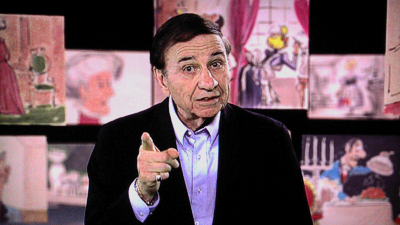
While the Studio could have simply recycled older AristoCats supplements, it’s nice to see them continue to bring new elements to their recent bunch of catalog releases, and The Lost Open provides a nice look at the film’s often overlooked development. More flippant, but also strangely absorbing, is a cobbled together Oui Oui Marie music video, also in HD. A hugely popular cartoon star in her own right in Japan, Duchess’ little kitten has a franchise all her own there, and this clip simply assembles various shots from the movie to accompany what could only be described as a Eurobeat mix, by D!tto, of vocoder-affected samplings of dialogue from Marie and her kitty-cat brothers. It really shouldn’t work…but it does, and despite this having nothing to do with the film or even making sense of its Oui Oui Marie title, I found myself returning to the clip, which runs to just under two minutes, quite a few times. Strange, bizarre, and typically Japanese in style, it’s a pointless but nevertheless totally captivating inclusion!

From the previous DVD, a Deleted Song: She Never Felt Alone is another delightful excursion with the always genial Richard Sherman, who plays us a few bars of a wistful song that is actually credited in the main titles, but seems to have been cut at the last minute. Sherman explains that he doesn’t know why the song was removed, but my guess would be for reasons of pacing: The AristoCats is an upbeat picture primarily – overall it could be described as a comedy thriller – leaving room only for a couple of spoken lines of this song in the completed version (hence the screen credit). Much like the reluctance to place a slow musical number in the later half of many recent Disney features, it was probably felt that a montage sequence and the reprise of the ballad would have ground things to a halt. Lucky for us, story sketches, concept art and original temp track demo recordings still exist, and these have been combined to present an idea of where and what this song moment and its reprise would have been like, running near eight minutes in total.
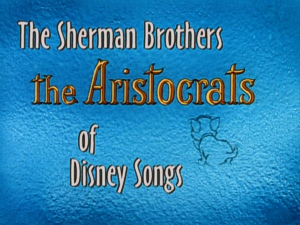
Following up on that song with its composers is The Sherman Brothers: The Aristocrats Of Disney Songs (the packaging and menu denote the Aristocats Of Disney Songs, but I’m going with the more suitable on-screen name also used on the DVD). It’s a nice idea but a little misplaced on this particular title, the truth being that the pair were in fact long gone from the Studio by the time The AristoCats hit screens, having left to seek work elsewhere after their champion Walt passed away. The Boys soon found themselves hard at work on other classic family musicals (Chitty Chitty Bang Bang, of course, The Slipper And The Rose and the original animated Charlotte’s Web among others), and so they weren’t at the Studio to protect the songs they had written for The AristoCats. Many fell by the wayside as the production twisted and turned through story development, with The Bare Necessities’ Terry Gilkyson again stepping in to provide Phil Harris’ character builder, while the movie’s big hit, Ev’rybody Wants To Be A Cat, was penned by Floyd Huddleston and Al Rinker, who would stay at the Studio and provide other songs for other projects.

But this is a nice tribute to the songwriters that gave us so many other memorable tunes over their many years writing for other Disney projects, and this featurette’s short nature, at only four and a half minutes, never really hinders things at all since the Brothers are always great value and pack in the anecdotes on their two full song contributions to this particular movie. It’s always a pleasure to sit in the company of the ever exuberant Richard Sherman and, due to this piece being recycled from several years ago, we again get to enjoy hearing from his brother Robert, who of course recently passed away. This new use of the piece doesn’t acknowledge that event but as a celebration of their creativity perhaps it didn’t need to: the Shermans’ work speaks for itself and will live on for many more generations yet. As an aside, the film’s songs can be played individually with optional lyrics onscreen as a Disney Song Selection option.
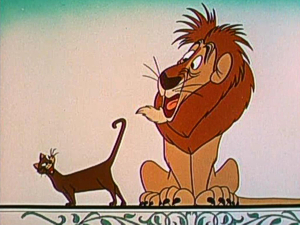
Seemingly stretching for material to include (hey, how about Ken Anderson’s Disney Family Album!?), we’re next offered a 13-minute sequence from a 1956 Wonderful World Of Disney program, an excerpt from The Great Cat Family. While this has nothing to do with the main feature and predates any development on the film by a decade, there is fun value in seeing any vintage Walt material, especially when it’s spruced up with exclusive animation like this slice is. While the link to The AristoCats is tenuous, it works, since Walt is expressing an interest in cats of the domesticated variety in general, and the lengthy animated sequence has fun in comically illustrating man’s fascination and long relationship with our feline friends. Think of this as the disc’s “Your Friend The Cat”, and that’s pretty much what you’ll get: some lovely, quality Disney animation – with one really stunning concept shot during an Egyptian hieroglyphic scene – rarely seen since its original broadcast. Pretty slinky!
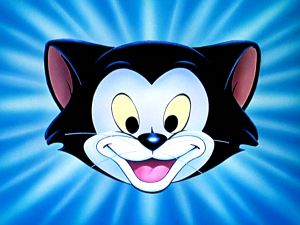
Still stretching things a bit is the inclusion of a Figaro cartoon, Bath Day – hey, it’s got a itty bitty kitty in it, right!? Again having not an ounce of a connection with the made-24 years later main feature, it must be admitted that it’s probably the best of the three solo shorts (previously all available in the second Walt Disney Treasures: The Complete Pluto set) to feature Geppetto’s frisky little kitten, he does share the same feistiness as Berlioz or Toulouse, and he does have a run in with an orange alley cat’s layabout chums that might have been some inspiration for…oh, look…now I’m stretching too! Nevertheless, if the intent is to provide disc value, one can’t argue with this 6½ minute inclusion, and it’s always healthy to see the Studio doing things with their vintage material other than leaving it on a shelf.
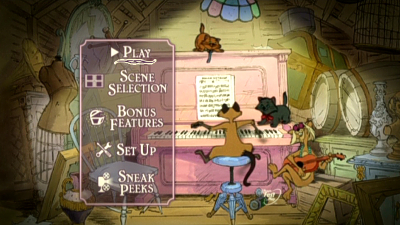
That’s it for the Blu-ray but very pleasingly the FastPlay enabled enclosed DVD isn’t a freshly minted new authoring of the kind Disney has been doing lately, so instead of just featuring one (or none!) token extras the disc included here is actually a replica of The AristoCats’ previous DVD release, uniquely preserving several extras not carried over to the BD. On loading the disc into a computer, the ever-cumbersome InterActual Player launches…and in my case promptly crashed again! However, having experience the feature on the previous disc it should lead to some limited DVD-ROM extras based around Virtual Kitten “activity” that works much as the Virtual Puppy we were once offered to look after on Lady And The Tramp’s DVD Platinum Edition.
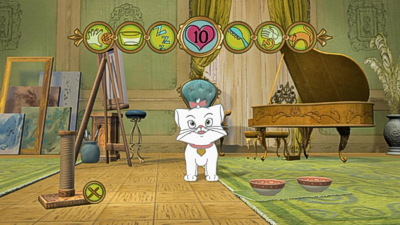
In a computer drive there are a few extra touches, such as a printable adoption certificate (though the accompanying music is pretty suspect!), and there’s a ser-top player edition too, even if there’s not much to do in either version apart from following the lead of the various icons (or “icaans” as the over enthusiastic voice-over host has them) and doing what the little (fairly ugly) approximations of Berlioz, Marie, Toulouse and a Figaro-like black kitty want to do. And if you don’t? Well they get bored, as did I. The Fun With Language Game fares a little better, not least for the entertaining educational value. Despite the odd title, the game centers on the title cats’ love of music, and the player must simply select the instrument called for. It’s aiming very young, of course, and the little notes could be more palpably applied to denote the instrument selected, but there are a handful of levels and it does what it does fairly enough.

The rest of the supplements pretty much repeat those to be found on the Blu-ray (there’s The Great Cat Family excerpt, the Sherman Brothers: AristoCats featurette and the deleted song), but best of all is a fairly sizable 68-image AristoCats Scapbook gallery, which showcases several of Ken Anderson’s Concept Art images that sold Walt on the animated film idea, and several pages of production drawings and stills taking us through Story Development, Character Design, Behind The Scenes, Publicity, Merchandise, the Premiere and even The AristoCats, or should that be the “Scat Cats”, characters at Disneyland. From the original Gold Edition, only a minor trivia game and a more welcome 1987 theatrical reissue trailer are missing (and could have easily been woven into the Scrapbook), but this is otherwise a nice smattering of extras that compliment the movie well enough.
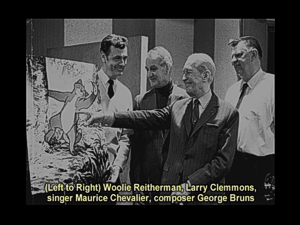
Case Study:
Having gone through various multiple cover art treatments over the years, The AristoCats finally looks to have landed an incarnation that represents the best aspects of some of the original theatrical posters, rendered in a lovely and lush modern way. Placing the title in the center of the sleeve, with primary character faces on top and a focus on the remaining feline faces, the combination here isn’t actually far off one of the film’s earliest publicity sheets, and of course being Paris set we even get the Eiffel Tower too. Inside, there’s an insert with a Movie Rewards code that also unlocks an exclusive offer for a free download of The AristoCats: Disney Classics Storybook App for Apple users that seems to feature a few extra games.
The sleeve art is also replicated on a glossily embossed slipcover with Disney’s usual blu-border in place, of course, although as on the previous DVD, the title here has been blanded out again so as to read as a straight “Aristocats” rather than how the original posters and indeed the actual titling within the film’s frames has it, with the capital C emphasizing the title’s pun (not to be confused, as Paul Reiser has done, with the punchline to the joke in the hilariously filthy The Aristocrats comedians’ documentary!). As with all of Disney’s August 21 Blu-rays, one of the stickers on slipcover offers $10 off the title when purchased with another concurrent releases, good up to September 30 2012.
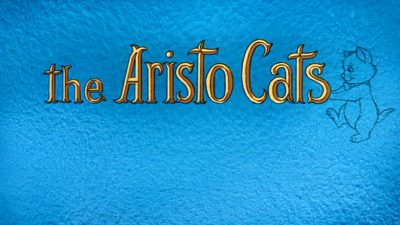
Ink And Paint:
I could bemoan the fact that The AristoCats has always been shown on VHS, LaserDisc and even initially on DVD in its “original theatrical aspect” of 1.33:1, but with the previous DVD (the one included here), Disney went all 16:9 on us and decided that the “original theatrical aspect” just now happened to be 1.75:1, a compromise ratio between the Academy framed animation and the wider-format screens that would crop the top and bottom theatrically (for the purposes of illustration the screengrabs for this review come from the bundled-in DVD). With this in mind, the artists did animate with these screen dimensions in mind, but those with the Gold Collection or LaserDisc edition may still want to hold on to those for the original aspect ratio dimensions.
Comparing them makes it clear that both framings are valid – back when The AristoCats was filmed the widely held belief was that future screenings of movies would be on the square-shaped televisions of the time only – but in fact the 1.33 doesn’t lose some of the tops of heads that the tighter framing on the top and bottom of the 1.75 formatting doesn’t allow for. Confounding us further is that this new HD transfer – assumedly from a different source since it reverts to the Buena Vista Distribution card and not the Walt Disney Pictures ident used on the DVD – presents the movie in a 1.66:1 ratio, which minimises the cropping of north and south in the image but protects the widescreen intentions, perhaps giving us the definitive screen presentation of the movie finally.
Pleasingly, The AristoCats also looks good in terms of a new digital restoration that betters even that previous DVD, which still suffers slightly from a mild gate weave and various nicks and scratches. Now the HD transfer – given a pristine digital wash in line with Disney’s premium Diamond Editions – truly warrants the “dazzling” sticker the DVD originally sported, this new imaging bringing out the Xerography of the artwork very fairly and especially giving the colors a nice boost. The backgrounds are supposed to look fairly subdued for the most part, jumping to saturated life for Ev’rybody Wants To Be A Cat, and here everything just looks purr-fect, beautiful even. What an unexpected and gorgeous surprise!
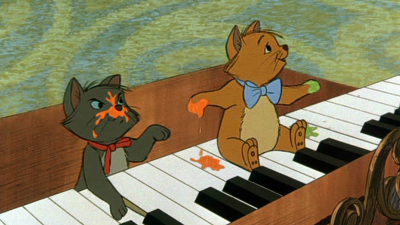
Scratch Tracks:
Originally released to selected theatrical engagements in the stereophonic sound process that Disney used for many of its prestige pictures in the early 1970s, the previous DVD expanded upon that to create a modern day 5.1 mix. The AristoCats’ score is among one of the most playful and layered in all of Disney, especially in the detective work scenes of Napoleon and Lafayette where composer George Bruns uses the kind of suspenseful orchestration that the likes of Lalo Schifrin was making a trademark of on shows such as Mission: Impossible, and this repeat of that same mix, now in lossless DTS, brings it out very nicely.
There were obviously good studio elements to work with and at times the track sounds much more modern than one would think: it seems there was an anticipation for the picture after Walt’s passing and The Jungle Book’s success that the sound recordists wanted to meet in terms of creativity, and the terrific music only helps the film sound rich and full. English, French and Spanish languages are all offered in subtitled or dubbed options, and it’s especially fun to watch with the French track enabled, where the foreign counterparts actually often bring an extra layer of dimension to their characters, for that extra touch of “Gallic authenticity”!
Final Cut:
Coming at a rough time for the Disney artists in the face of losing their guiding light and with heaps of pressure on them to still deliver the quality, ethics and box-office expected of a Walt Disney production, The AristoCats turns in a good-looking, entertaining and surprisingly contemporary feeling picture, despite its period setting, that was successful enough – especially hugely in France – to continue the Disney Animation tradition. That it was also one of the first Disney features I can remember seeing (originally as way back as from old 8mm excerpts!) probably has a part to play in my continuing to defend the picture!
In recent years I’m happy to see that home video has brought about a new recognition for the film and, by the time of this release, it seems it has earned its place high within the revered line up of Walt Disney’s final films and as one of his Studio’s true classics. With its cute felines and crazy cats, it’s a rare animated family movie where there really is something for everyone to enjoy, from little Marie’s hissyfits, to Edgar’s twisted scheming and Duchess and O’Malley’s unexpectedly mature romance. Looking and sounding the absolute best it ever has done, ev’rybody will want to own these cats – c’est magnifique!
 | ||
 [1] [1] |
- [Image]: http://www.amazon.com/exec/obidos/ASIN/%20B0084IHVC0/animatedviews-20
Source URL: https://animatedviews.com/2012/the-aristocats-special-edition-blu-ray/